
The photo is of a pastor at my church who is from Zimbabwe — Ngonidzaishe Mukarakate. He goes by Ngoni. He and his wife and four children came to Dallas from Zimbabwe several years ago. There are also two other African pastors at Lovers Lane United Methodist Church — Uwezo Mwanjala and Julius Collins. The African members of the church started growing back in the 1980s when the church had an ad campaign featuring billboards with photos of various members with the tagline “Wanna Know Why” which was a website featuring a deaf member, a disabled member and a member from Liberia, among others. They all told why they joined the church. After the marketing campaign, the numbers of deaf, disabled and African people joining the church increased considerably. Ngoni, Uwezo and Julius are all members of the African Fellowship within LLUMC. Today Ngoni spoke to our Sunday school class about his journey as an immigrant, a parent and a pastor. Let’s learn more about his home country, Zimbabwe.

According to Wikipedia, Zimbabwe, officially the Republic of Zimbabwe, is a landlocked country located in Southeast Africa, between the Zambezi and Limpopo Rivers, bordered by South Africa to the south, Botswana to the southwest, Zambia to the north and Mozambique to the east. The capital and largest city is Harare. The second largest city is Bulawayo. A country of roughly 15 million people, Zimbabwe has 16 official languages, with English, Shona and Ndebele the most common. It was once known as the "Jewel of Africa" for its great prosperity.
Zimbabwe has one of the richest histories of any nation in southern Africa, and first became a major trade route in the 11th century. During its late iron age, the Gokomere, the Bantu people who would become the ethnic Shona built the vast city-state of Great Zimbabwe. Built on a wealth of natural resources, Great Zimbabwe flourished financially and culturally from the 14th to 15th centuries, becoming a mercantile powerhouse that controlled the gold, ivory and copper trades with the Swahili coast and various Arab and Indian states. From there, the powerful Kingdom of Zimbabwe was established, followed by the Rozvi, Mutapa and Mthwakazi empires. The Shona and Ndebele peoples, among others, had shaped Zimbabwe into a prosperous and strategically important region when Europeans began to colonize the area in the 1800s.
The British South Africa Co. of Cecil Rhodes first demarcated the present territory during 1890 when they conquered Mashonaland and later in 1893 Matabeleland after a fierce resistance by Matabele people known as the First Matabele War. Company rule ended in 1923 with the establishment of Southern Rhodesia as a self-governing British colony. In 1965, the conservative white minority government unilaterally declared independence as Rhodesia. The state endured international isolation and a 15-year guerrilla war with black nationalist forces; this culminated in a peace agreement that established universal enfranchisement and de jure sovereignty as Zimbabwe in April 1980. Zimbabwe then joined the Commonwealth of Nations, from which it was suspended in 2002 for breaches of international law by its then-government under Robert Mugabe, and from which it withdrew in December 2003.
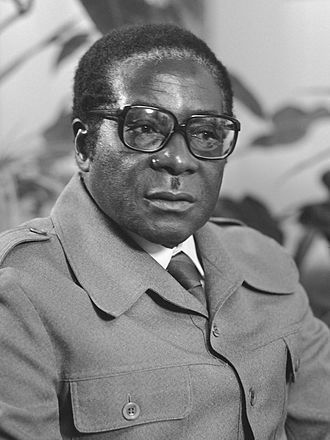
Robert Mugabe became Prime Minister of Zimbabwe in 1980, when his ZANU–PF party won the elections following the end of white minority rule; he was the President of Zimbabwe from 1987 until his resignation in 2017. Under Mugabe's authoritarian regime, the state security apparatus dominated the country and was responsible for widespread human rights violations. From 2000 to 2009 the economy experienced decline and hyperinflation before rebounding after the use of currencies other than the Zimbabwean dollar was permitted, though growth has since faltered. On November 15, 2017, in the wake of over a year of protests against his government as well as Zimbabwe's rapidly declining economy, Mugabe was placed under house arrest by the country's national army in a coup d'état and eventually resigned six days later. Emmerson Mnangagwa has since served as Zimbabwe's president.
Zimbabwe is a member of the United Nations, the Southern African Development Community, the African Union and the Common Market for Eastern and Southern Africa.
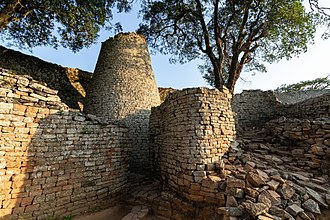
Etymology
The name "Zimbabwe" stems from a Shona term for Great Zimbabwe, a medieval city — Masvingo — in the country's southeast whose remains are now a protected site. Two different theories address the origin of the word. Many sources hold that "Zimbabwe" derives from dzimba-dza-mabwe, translated from the Karanga dialect of Shona as "houses of stones" — dzimba = plural of imba, "house"; mabwe = plural of bwe, "stone." The Karanga-speaking Shona people live around Great Zimbabwe in the modern-day province of Masvingo. Archaeologist Peter Garlake claims that "Zimbabwe" represents a contracted form of dzimba-hwe, which means "venerated houses" in the Zezuru dialect of Shona and usually references chiefs' houses or graves.
Zimbabwe was formerly known as Southern Rhodesia in 1898, Rhodesia in 1965 and Zimbabwe Rhodesia in 1979. The first recorded use of "Zimbabwe" as a term of national reference dates from 1960 as a coinage by the black nationalist Michael Mawema, whose Zimbabwe National Party became the first to officially use the name in 1961. The term "Rhodesia" — derived from the surname of Cecil Rhodes, the primary instigator of British colonization of the territory during the late 19th century — was perceived by African nationalists as inappropriate because of its colonial origin and connotations.
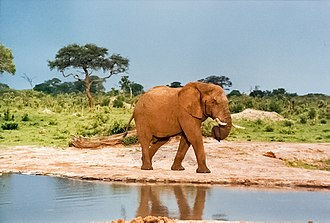
Biodiversity
Zimbabwe contains seven terrestrial ecoregions: Kalahari Acacia-Baikiaea woodlands, Southern Africa bushveld, Southern miombo woodlands, Zambezian Baikiaea woodlands, Zambezian and mopane woodlands, Zambezian halophytics and Eastern Zimbabwe montane forest-grassland mosaic.
The country is mostly savannah, although the moist and mountainous eastern highlands support areas of tropical evergreen and hardwood forests. Trees found in these Eastern Highlands include teak, mahogany, enormous specimens of strangling fig, forest Newtonia, big leaf, white stinkwood, chirinda stinkwood, knobthorn and many others.
In the low-lying parts of the country fever trees, mopane, combretum and baobabs abound. Much of the country is covered by miombo woodland, dominated by brachystegia species and others. Among the numerous flowers and shrubs are hibiscus, flame lily, snake lily, spider lily, leonotus, cassia, tree wisteria and dombeya. There are around 350 species of mammals that can be found in Zimbabwe. There are also many snakes and lizards, over 500 bird species and 131 fish species.

Tourism
Zimbabwe has several major tourist attractions. Victoria Falls on the Zambezi, which are shared with Zambia, are located in the northwest of Zimbabwe. Before the economic changes, much of the tourism for these locations came to the Zimbabwe side but now Zambia is the main beneficiary. The Victoria Falls National Park is also in this area and is one of the eight main national parks in Zimbabwe, the largest of which is Hwange National Park.
The Eastern Highlands are a series of mountainous areas near the border with Mozambique. The highest peak in Zimbabwe — Mount Nyangani at 8,507 feet — is located there as well as the Bvumba Mountains and the Nyanga National Park. World's View is in these mountains and it is from here that places as far away as 37–43 miles are visible and, on clear days, the town of Rusape can be seen.
Zimbabwe is unusual in Africa in that there are a number of ancient and medieval ruined cities built in a unique dry stone style. Among the most famous of these are the Great Zimbabwe ruins in Masvingo. Other ruins include Khami Ruins, Zimbabwe, Dhlo-Dhlo and Naletale.
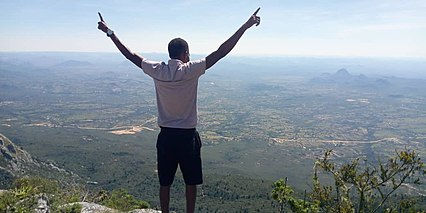
The Matobo Hills are an area of granite kopjes and wooded valleys commencing some 22 miles south of Bulawayo in southern Zimbabwe. The hills were formed over 2,000 million years ago with granite being forced to the surface, then being eroded to produce smooth "whaleback dwalas" and broken kopjes, strewn with boulders and interspersed with thickets of vegetation. Mzilikazi, founder of the Ndebele nation, gave the area its name, meaning “Bald Heads.” They have become a tourist attraction due to their ancient shapes and local wildlife. Cecil Rhodes and other early white colonists like Leander Starr Jameson are buried in these hills at a site named World's View.
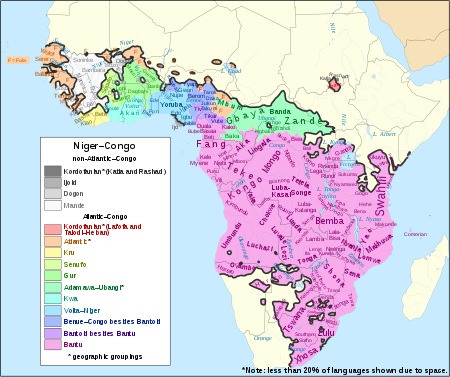
Languages
English is the main language used in the education and judicial systems. The Bantu languages Shona and Ndebele are the principal indigenous languages of Zimbabwe. Shona is spoken by 78% of the population, Ndebele by 20%. Other minority Bantu languages include Venda, Tsonga, Shangaan, Kalanga, Sotho, Ndau and Nambya. Less than 2.5% — mainly the white and "colored" or mixed-race minorities — consider English their native language. Shona has a rich oral tradition, which was incorporated into the first Shona novel, “Feso” by Solomon Mutswairo, published in 1956. English is spoken primarily in the cities, but less so in rural areas. Radio and television news is broadcast in Shona, Sindebele and English.
Due to its large border with Mozambique, there is a large community of Portuguese speakers in Zimbabwe, mainly in the border areas with Mozambique and in major cities, such as Harare and Bulawayo. Beginning in 2017, teaching Portuguese was included in secondary education of Zimbabwe.
Zimbabwe has 16 official languages and under the constitution, an Act of Parliament may prescribe other languages as officially recognized languages.

Culture
Zimbabwe has many different cultures which may include beliefs and ceremonies, one of them being Shona, Zimbabwe's largest ethnic group. The Shona people have many sculptures and carvings which are made with the finest materials available.
Zimbabwe first celebrated its independence on April 18, 1980. Celebrations are held at either the National Sports Stadium or Rufaro Stadium in Harare. The first independence celebrations were held in 1980 at the Zimbabwe Grounds. At these celebrations, doves are released to symbolize peace; fighter jets fly over. The national anthem is sung. The flame of independence is lit by the president after parades by the presidential family and members of the armed forces of Zimbabwe. The president also gives a speech to the people of Zimbabwe which is televised for those unable to attend the stadium. Zimbabwe also has a national beauty pageant — the Miss Heritage Zimbabwe contest — which has been held annually ever since 2012.
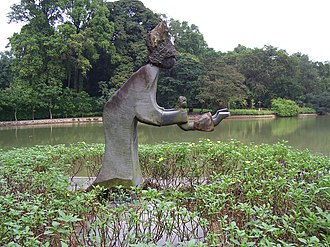
Arts
Traditional arts in Zimbabwe include pottery, basketry, textiles, jewelery and carving. Among the distinctive qualities are symmetrically patterned woven baskets and stools carved out of a single piece of wood. Shona sculpture has become better known after finding initial popularity in the 1940s. Most subjects of carved figures of stylized birds and human figures, among others, are made with sedimentary rocks such as soapstone, as well as harder igneous rocks such as serpentine and the rare stone verdite. Zimbabwean artefacts can be found in countries like Singapore, China and Canada. e.g., Dominic Benhura's statue in the Singapore Botanic Gardens.
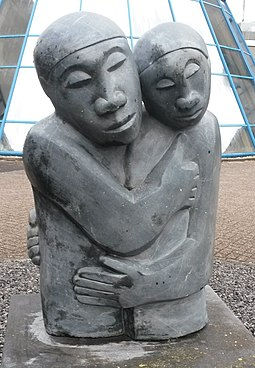
Shona sculpture has survived through the ages and the modern style is a fusion of African folklore with European influences. World-renowned Zimbabwean sculptors include Nicholas, Nesbert and Anderson Mukomberanwa, Tapfuma Gutsa, Henry Munyaradzi and Locardia Ndandarika. Internationally, Zimbabwean sculptors have managed to influence a new generation of artists, particularly black Americans, through lengthy apprenticeships with master sculptors in Zimbabwe. Contemporary artists like New York sculptor M. Scott Johnson and California sculptor Russel Albans have learned to fuse both African and Afro-diasporic aesthetics in a way that travels beyond the simplistic mimicry of African art by some black artists of past generations in the United States.

Several authors are well known within Zimbabwe and abroad. Charles Mungoshi is renowned in Zimbabwe for writing traditional stories in English and in Shona, and his poems and books have sold well with both the black and white communities. Catherine Buckle has achieved international recognition with her two books “African Tears” and “Beyond Tears” which tell of the ordeal she went through under the 2000 Land Reform. The first Prime Minister of Rhodesia, Ian Smith, wrote two books — “The Great Betrayal” and “Bitter Harvest.” The book “The House of Hunger” by Dambudzo Marechera won an award in the UK in 1979 and the Nobel Prize-winning author Doris Lessing's first novel “The Grass Is Singing,” the first four volumes of “The Children of Violence” sequence and the collection of short stories “African Stories” are set in Rhodesia. In 2013 NoViolet Bulawayo's novel “We Need New Names” was shortlisted for the Booker Prize. The novel tells the story of the devastation and emigration caused by the brutal suppression of Zimbabwean civilians during the Gukurahundi in the early 1980s.
Notable artists include Henry Mudzengerere and Nicolas Mukomberanwa. A recurring theme in Zimbabwean art is the metamorphosis of man into beast. Zimbabwean musicians like Thomas Mapfumo, Oliver Mtukudzi, the Bhundu Boys, Stella Chiweshe, Alick Macheso and Audius Mtawarira have achieved international recognition. Among members of the white minority community, theatre has a large following, with numerous theatrical companies performing in Zimbabwe's urban areas.
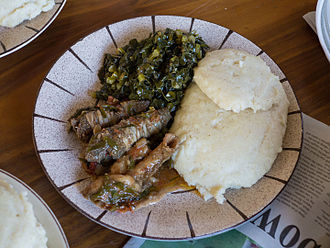
Cuisine
Like in many African countries, the majority of Zimbabweans depend on a few staple foods. "Mealie meal" — also known as cornmeal — is used to prepare sadza or isitshwala, as well as porridge known as bota or ilambazi. Sadza is made by mixing the cornmeal with water to produce a thick paste/porridge. After the paste has been cooking for several minutes, more cornmeal is added to thicken the paste.
This is eaten as lunch or dinner, usually with sides such as gravy, vegetables — spinach, chomolia or spring greens/collard greens, beans and meat (stewed, grilled, roasted or sundried). Sadza is also commonly eaten with curdled milk or sour milk, commonly known as "lacto," or dried Tanganyika sardine, known locally as kapenta or matemba. Bota is a thinner porridge, cooked without the additional cornmeal and usually flavored with peanut butter, milk, butter or jam. Bota is usually eaten for breakfast.
Graduations, weddings and any other family gatherings will usually be celebrated with the killing of a goat or cow, which will be barbecued or roasted by the family.
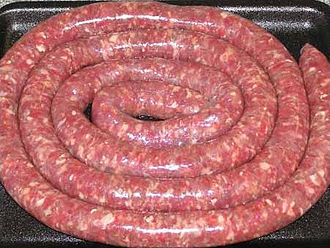
Even though the Afrikaners are a small group of 10% within the white minority group, Afrikaner recipes are popular. Biltong, a type of jerky, is a popular snack, prepared by hanging bits of spiced raw meat to dry in the shade. Boerewors is served with sadza. It is a long sausage, often well-spiced, composed of beef rather than pork and barbecued.
As Zimbabwe was a British colony, some people there have adopted some colonial-era English eating habits. For example, most people will have porridge in the morning, as well as 10 o'clock tea or midday tea. They will have lunch — often leftovers from the night before, freshly cooked sadza or sandwiches, which is more common in the cities. After lunch, there is usually 4 o'clock tea or afternoon tea, which is served before dinner. It is not uncommon to have tea after dinner.
Rice, pasta and potato-based foods such as french fries and mashed potatoes also make up part of Zimbabwean cuisine. A local favorite is rice cooked with peanut butter, which is taken with thick gravy, mixed vegetables and meat. A potpourri of peanuts known as nzungu, boiled and sundried maize, black-eyed peas known as nyemba and bambara groundnuts known as nyimo make a traditional dish called mutakura. Mutakura can also be the above ingredients cooked individually.
One can also find local snacks, such as maputi or roasted/popped maize kernels similar to popcorn, roasted and salted peanuts, sugar cane, sweet potato, pumpkin and indigenous fruits such as horned melon, gaka, adansonia, mawuyu, uapaca kirkiana, mazhanje or sugar plum and many others.
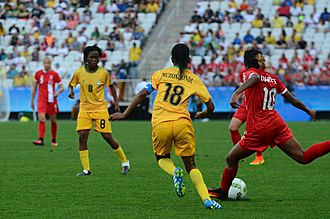
Sports
Football — also known as soccer — is the most popular sport in Zimbabwe. The Warriors have qualified for the Africa Cup of Nations five times (2004, 2006, 2017, 2019, 2021), and won the Southern Africa championship on six occasions (2000, 2003, 2005, 2009, 2017, 2018) and the Eastern Africa cup once (1985). The team is ranked 115th in the world (FIFA World Rankings Nov 2018).
Rugby union is a significant sport in Zimbabwe. The national side have represented the country at two Rugby World Cup tournaments in 1987 and 1991. The team are ranked 26th in the world by World Rugby.
Cricket also has a following among the white minority. It is one of twelve Test cricket playing nations and an International Cricket Council full member as well. Notable cricket players from Zimbabwe include Andy Flower, Heath Streak and Brendan Taylor.
Zimbabwe has won eight Olympic medals, one in field hockey with the women's team at the 1980 Summer Olympics in Moscow, and seven by swimmer Kirsty Coventry, three at the 2004 Summer Olympics and four at the 2008 Summer Olympics.
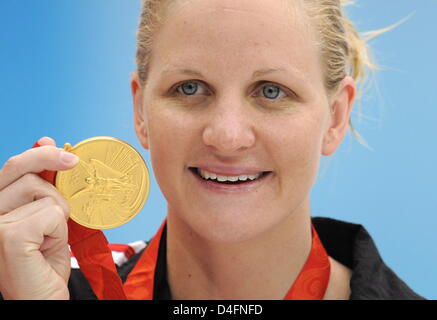
Zimbabwe has also done well in the Commonwealth Games and All-Africa Games in swimming with Kirsty Coventry obtaining 11 gold medals in the different competitions. Zimbabwe has also competed at Wimbledon and the Davis Cup in tennis, most notably with the Black family, which comprises Wayne Black, Byron Black and Cara Black. Zimbabwe has also done well in golf. The Zimbabwean Nick Price held the official World No. 1 status longer than any player from Africa has ever done in the 24-year history of the ranking.
Other sports played in Zimbabwe are basketball, volleyball, netball, and water polo, as well as squash, motorsport, martial arts, chess, cycling, polocrosse, kayaking and horse racing. However, most of these sports do not have international representatives but instead stay at a junior or national level.
Comentarios